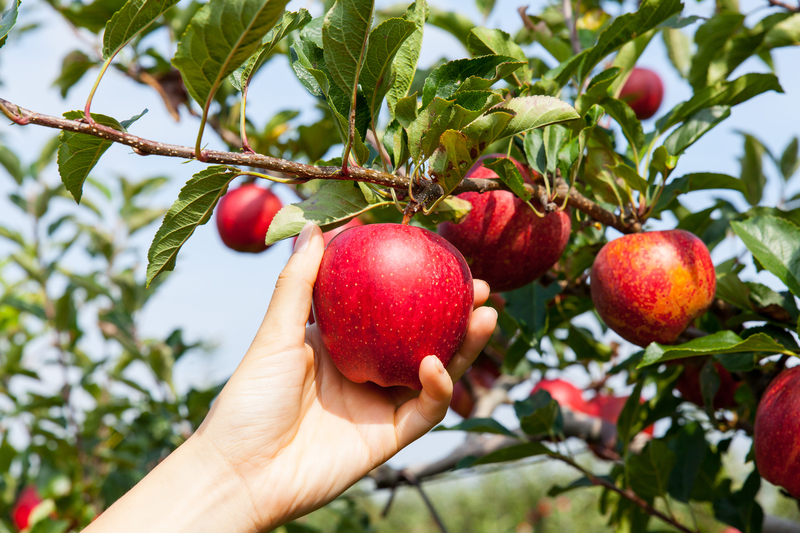A Green Thumb's Journey to a Lush Herb Garden
Posted on 18/09/2025
A Green Thumb's Journey to a Lush Herb Garden
Have you ever dreamed of stepping outside to a verdant, aromatic oasis, where a simple snip provides the key to fresh, flavorful meals and natural wellness? Cultivating your own herb garden is more than a hobby--it's a journey of passion, patience, and plenty of green rewards. This comprehensive guide will accompany you, from a tiny seedling of curiosity to the flourishing greenery of an abundant herb garden in your backyard, balcony, or even windowsill.

Why Start a Herb Garden?
A lush herb garden isn't just visually appealing; it's a sanctuary for the senses and a source of fresh, organic flavors right at home. Whether you're a seasoned green thumb or a budding enthusiast, cultivating herbs offers endless benefits:
- Elevated Cuisine: Add zest and aroma to your cooking with homegrown herbs.
- Natural Remedies: Many culinary herbs double as medicinal plants, boosting wellness naturally.
- Sustainable Living: Grow organically, reduce waste, and minimize carbon footprint.
- Cost-Effective: Save on frequent supermarket trips and costly packaged herbs.
- Therapeutic Hobby: Gardening soothes the mind, reduces stress, and connects us to nature.
Choosing Your Herb Garden's Paradise
Assessing Space and Sunlight
Before you sow the seeds of your herbal paradise, evaluate the available space and sunlight. Do you have a spacious backyard, a sunny balcony, or a bright windowsill? Most herbs thrive in full sunlight, requiring at least 6 hours of direct sun each day. For those with less space, container herb gardens or vertical arrangements can yield equally lush results.
Indoor vs. Outdoor Herb Gardens
- Outdoor Herb Gardens: Ideal for those with yard space. Outdoor beds allow for larger crops and a wider variety of herbs. Raised beds or traditional in-ground plots are excellent choices for a bountiful harvest.
- Indoor Herb Gardens: Perfect for urban dwellers. Windowsills, hanging baskets, or countertop planters can sprout thriving green sanctuaries. Just ensure your herbs receive ample light.
Selecting the Right Herbs for Your Garden
The secret to a successful organic herb garden is starting with the right selection of plants. Consider your climate, available space, and personal preferences. Here are some beginner-friendly and indispensable culinary herbs to include on your gardening journey:
- Basil: The fragrant king of Italian cuisine, fast-growing and suitable for containers.
- Mint: Hardy and invigorating, but best grown in pots to contain its spread.
- Rosemary: A robust perennial with woody stems and needle-like leaves perfect for roasts and breads.
- Thyme: Tiny leaves with big flavor, ideal for borders and rock gardens.
- Parsley: Biennial but commonly grown as an annual; versatile in garnishes and salads.
- Cilantro: Adds zest to Mexican and Asian cuisine, but prefers cooler weather.
- Oregano: A Mediterranean staple, drought-resistant and full-bodied in sauces and pizzas.
- Chives: Grass-like and mild, a great addition to eggs and soups.
- Sage: Earthy and aromatic, essential for savory stuffing and meat dishes.
Tip: Embrace diversity in your herb garden--a mixture of annuals and perennials ensures continual harvests throughout the year.
Preparing the Perfect Soil for Herbs
The Ideal Soil Mix
Healthy soil is the foundation of a lush herb garden. Most herbs prefer well-draining, moderately fertile soil. To concoct the ideal growing medium:
- Use organic compost: Enriches the soil and aids in moisture retention.
- Ensure good drainage: Add sand or perlite for improved aeration.
- Avoid heavy clay or waterlogged soils--herbs dislike "wet feet."
Soil pH and Nutrients
Most culinary herbs thrive in a soil pH of 6.0 to 7.0, which is just slightly acidic to neutral. Regularly test your garden soil and adjust with lime or sulfur as necessary. Organic fertilizers or nutrient-rich compost should be applied sparingly; herbs prefer lean conditions that encourage flavor concentration.
Sowing Seeds or Planting Seedlings: The Best Start
A home herb garden can be started from seeds or young plants (transplants). Here's a detailed comparison to help you decide:
-
Seeds:
- More affordable and offer a greater variety of herb types.
- Require patience as they take longer to establish.
- Perfect for large outdoor beds or experienced gardeners.
-
Seedlings/Transplants:
- Provide instant greenery and quicker harvests.
- Available at most nurseries and easy to plant.
- Ideal for beginners or indoor herb gardens.
Pro tip: For herbs like basil, cilantro, and parsley, direct seeding is effective. For woody perennials such as rosemary and sage, opt for healthy young plants.
Planting Techniques for Success
Outdoor Herb Garden Planting
- Select a sunny, sheltered spot with well-prepared soil.
- Sow seeds or plant seedlings at recommended spacings (check seed packets for specifics).
- Water gently but thoroughly to settle roots.
- Mulch around plants to retain moisture and suppress weeds.
Container Herb Gardens
- Choose pots with drainage holes to prevent root rot.
- Use a high-quality potting mix combined with compost.
- Group herbs with similar light and water needs together.
- Place containers in your sunniest window or balcony ledge.
Spacing is key to preventing disease and giving each herb room to flourish in your lush garden.
Year-Round Care for a Thriving Herb Garden
Watering Wisdom
- Most herbs prefer soil that is moist but never soggy.
- Water in the early morning or evening to reduce evaporation.
- Allow the soil's surface to dry between waterings for strong root growth.
Fertilizing for Flavor
- Use organic fertilizer or compost every 6-8 weeks during the growing season.
- Avoid over-fertilizing to maintain concentrated, robust flavors in your herbs.
Pruning and Harvesting
- Regular harvesting encourages bushier growth and a longer production season.
- Pinch back leafy herbs (like basil and mint) just above leaf nodes to encourage branching.
- Never remove more than one-third of the plant at a time.
Dealing with Pests and Common Problems
Natural Pest Control
A lush herb garden is not immune to pests, but you can minimize damage the organic way:
- Inspect your herbs regularly for aphids, spider mites, and caterpillars.
- Encourage beneficial insects like ladybugs and lacewings.
- Spray with homemade garlic or neem oil solutions as needed.
- Remove affected leaves and dispose of infested plants carefully.
Disease Prevention
- Space your plants well and avoid overhead watering to prevent fungal diseases.
- Rotate container plants and refresh soil between seasons.
- Remove plant debris and clear weeds regularly.
Extending the Harvest: Preserving Your Herbs
Once you experience the sheer abundance of a lush green herb garden, you'll want to savor the harvest year-round. Thankfully, herbs are easy to preserve:
- Drying: Hang bundles of herbs upside down in a cool, airy place until crisp.
- Freezing: Chop herbs and store in ice cube trays with water or olive oil.
- Infusing: Make your own oils, vinegars, or butters with fresh herbs for future use.
Preserved herbs retain their essential oils and can elevate your cooking and teas even during the winter months.
Creative Uses for Your Homegrown Herbs
Culinary Delights
- Garnish salads, soups, and pasta with fresh-cut herbs.
- Infuse beverages and desserts with mint, basil, or lemon balm.
- Craft your own herb butter, pesto, or spice blends.
Health and Wellness
- Brew soothing teas with chamomile or peppermint.
- Prepare homemade skin care remedies using rosemary or lavender.
- Use sage or thyme as natural disinfectants for the home.
Green Thumb Tips for a Flourishing Herb Oasis
Consistency is the heart of an abundant herb garden. Keep these tips in mind:
- Label your herbs: Especially helpful when getting started or trying new varieties.
- Rotate containers or reposition pots seasonally to follow the sunlight.
- Stay vigilant for signs of stress--yellowing leaves or leggy growth can signal a need for adjustments in care.
- Don't be afraid to experiment! Try lesser-known favorites like tarragon, lovage, or lemongrass.
- Share cuttings and seedlings with friends to expand your green network!

Frequently Asked Questions: Navigating Your Herb Gardening Journey
How much sunlight do herbs need?
Most herbs require at least 6 hours of direct sunlight each day. Mediterranean varieties like rosemary, thyme, and oregano particularly thrive under full sun. If growing indoors, choose the brightest window or supplement with grow lights.
What are the easiest herbs to grow for beginners?
Basil, mint, chives, and parsley are among the most forgiving and productive herbs for novices. They adapt to a range of conditions and offer steady harvests.
Why do my herbs get leggy?
Legginess (tall, sparse growth) is often a symptom of insufficient light. Move containers to a sunnier location or trim back aggressively to encourage bushier growth.
How often should I water my herb garden?
Water when the top inch of soil feels dry. Overwatering can be as detrimental as underwatering, so assess each plant's needs individually.
Is it better to grow herbs from seeds or cuttings?
Both methods are valid, but some herbs (like basil and cilantro) are easiest from seed, while others (like mint or rosemary) root quickly from cuttings.
Conclusion: Cultivating Joy with Your Lush Herb Garden
From the first sprout to your bountiful harvest, the journey to a lush herb garden is rich with sensory pleasures and personal rewards. Not only will you enjoy fresh, vibrant flavors in your kitchen, but you'll also cultivate a connection to nature that rejuvenates the mind and soul.
Start small, experiment with new varieties, and nurture your tiny green kingdom--soon, you'll be harvesting much more than just herbs; you'll be reaping a lifelong passion for gardening!
Let your green thumb lead the way, and embrace the adventure--your lush, thriving herb garden awaits!



